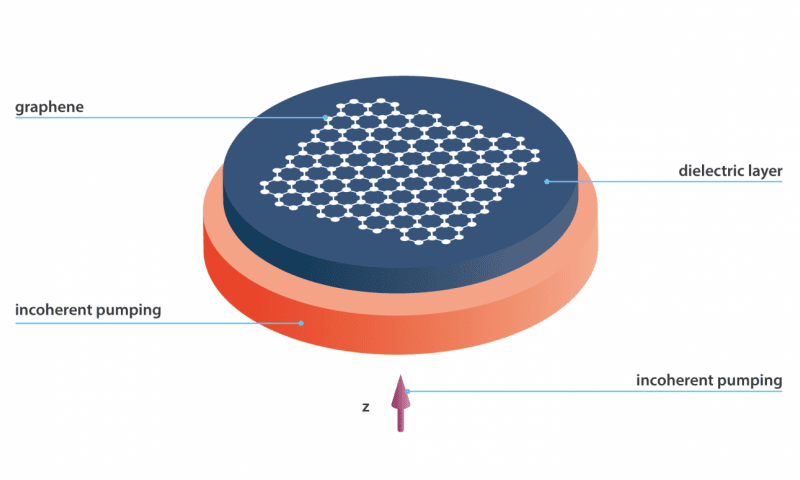Sniffer Plasmonic Sensor To Detect Single Molecule Of Explosives
Currently, we are in a science-based society where technology has distributed its tentacles in various sectors including defense and security. A group of Scientists from Moscow Institute of Physics and Technology (MIPT) has chosen graphene to be the most suitable material to devise a plasmonic sensor that can detect single molecule based explosives.
Being relatively new, the topic “plasmonics†is regarded as the study of the interaction between the electromagnetic field and free electrons in a metal. The word plasmon means the quantum of plasma oscillations where plasma is the fourth physical state defined just like solid, liquid and gas. While they alone are important to understand the basic physics, their interaction with light generating EM waves in a confined surface is of greater importance.
 The Design Of SPASER
The Design Of SPASER
The interaction generates a special output known as surface plasmon polariton (SPPs) which has a shorter wavelength than photons directly affecting the local field intensity by scaling it up. Such properties come with immense benefits to offer in the field of high-accuracy electronics and optics. When studied in detail, these properties reveal an area called sub-wavelength light focusing that makes it sensitive enough to detect a single molecule.
However, having such sensing element could not be directed to proper usage if it was to be localized in a conventional metal. Generally, plasmons tend to dissipate their energy quickly in such a metal guide. To stick to its energized state, the research team has optimized honeycomb structured magic material graphene which boasts of high charge carrier mobility, electrical conductivity, and a predefined microstructure.
According to the MIPT team, the plasmonics based quantum amplifier was numerically judged by using quantum mechanical equations. The structure design was achieved in the Laboratory of Nanostructure Spectroscopy under the surveillance of Prof. Yurii Lozovik. The research has taken the step to generalize a quantum model that suggests plasmonic behavior in graphene.
Finally, the same team has also proposed a prototype named “Spaser†that involves a nanoplasmonic notion of a laser. Also, a surface-plasmon-emitting diode (SPED) was documented in the same paper. A SPASER works as a LASER (coherent source), except that it relies on the optical gain medium and throws surface plasmons as the emitted particles instead of photons. The SPED being different from the former instrument it comes out to be an incoherent source of surface plasmons.
Both the instruments can act as a significant innovation for future development in defense-related machines. According to Alexander Dorofeenko, the properties of SPASER could be crafted to originate compact spectral measurement devices that are capable of detecting a single molecule of organic toxins using their fingerprint element i.e. vibrational transitions. In both cases, the system works in the infrared region. The complete research paper is published in Physical Review B.
Source: <a href="https://journals.aps.org/prb/abstract/10.1103/PhysRevB.94.035406" target="_blank" rel="nofollow noopener noreferrer">403 Forbidden</a>
Being relatively new, the topic “plasmonics†is regarded as the study of the interaction between the electromagnetic field and free electrons in a metal. The word plasmon means the quantum of plasma oscillations where plasma is the fourth physical state defined just like solid, liquid and gas. While they alone are important to understand the basic physics, their interaction with light generating EM waves in a confined surface is of greater importance.
 The Design Of SPASER
The Design Of SPASERThe interaction generates a special output known as surface plasmon polariton (SPPs) which has a shorter wavelength than photons directly affecting the local field intensity by scaling it up. Such properties come with immense benefits to offer in the field of high-accuracy electronics and optics. When studied in detail, these properties reveal an area called sub-wavelength light focusing that makes it sensitive enough to detect a single molecule.
However, having such sensing element could not be directed to proper usage if it was to be localized in a conventional metal. Generally, plasmons tend to dissipate their energy quickly in such a metal guide. To stick to its energized state, the research team has optimized honeycomb structured magic material graphene which boasts of high charge carrier mobility, electrical conductivity, and a predefined microstructure.
According to the MIPT team, the plasmonics based quantum amplifier was numerically judged by using quantum mechanical equations. The structure design was achieved in the Laboratory of Nanostructure Spectroscopy under the surveillance of Prof. Yurii Lozovik. The research has taken the step to generalize a quantum model that suggests plasmonic behavior in graphene.
Finally, the same team has also proposed a prototype named “Spaser†that involves a nanoplasmonic notion of a laser. Also, a surface-plasmon-emitting diode (SPED) was documented in the same paper. A SPASER works as a LASER (coherent source), except that it relies on the optical gain medium and throws surface plasmons as the emitted particles instead of photons. The SPED being different from the former instrument it comes out to be an incoherent source of surface plasmons.
Both the instruments can act as a significant innovation for future development in defense-related machines. According to Alexander Dorofeenko, the properties of SPASER could be crafted to originate compact spectral measurement devices that are capable of detecting a single molecule of organic toxins using their fingerprint element i.e. vibrational transitions. In both cases, the system works in the infrared region. The complete research paper is published in Physical Review B.
Source: <a href="https://journals.aps.org/prb/abstract/10.1103/PhysRevB.94.035406" target="_blank" rel="nofollow noopener noreferrer">403 Forbidden</a>
0

